The Toyota Sequoia is not afraid of heavy loads. It has a max rating of 9,520 pounds. This makes it a top choice for hauling campers, boats, or work trailers.
Its power comes from the i-FORCE MAX hybrid engine. It produces 583 lb-ft of torque. This is great for climbing steep hills or long trips.
Not all trims are the same. Your choice of setup is important. The available tow package and reinforced chassis help a lot.
Even base models are impressive. But, higher trims offer more tech. This includes Pro Trailer Assist and weight-distribution hitch support for better towing.
New to towing? No worries. Even experienced users will love the Sequoia. We’ll show you how to choose the right equipment. And we’ll give tips for any towing job, big or small.
Why Towing Capacity Matters for SUV Owners
Knowing your SUV’s haul capacity is key to safe adventures and a healthy vehicle. Here are three important things every Toyota Sequoia owner should know before towing.
Payload vs. Towing: The Balancing Act
Your Sequoia can carry up to 1,730 lb of weight, including passengers and gear. This is like a backpack for your SUV. The towing capacity, up to 9,520 lbs, is what you can pull behind you. Let’s see how they work together:
| Component | 2023 Sequoia | 2022 V8 Model |
|---|---|---|
| Max Payload | 1,730 lbs | 1,620 lbs |
| Max Towing | 9,520 lbs | 7,400 lbs |
| Tongue Weight Limit | 953 lbs | 740 lbs |
Safety First: When Limits Get Crossed
Going over your SUV’s towing limit is not just illegal, it’s also risky. Overloading can:
- Increase stopping distance by 20-40%
- Overheat brakes on mountain descents
- Trigger premature tire wear
The Sequoia’s trailer sway control helps, but it can’t make up for too much weight. Remember, that 9,520 lb max is for perfect conditions with the right equipment.
Long-Term Care for Heavy Haulers
Regular towing needs extra care. Toyota suggests:
- Transmission fluid changes every 30,000 miles
- Brake inspections every 15,000 miles
- Cooling system flushes annually
These steps are vital if you often use 80%+ of your Sequoia’s towing capacity. They’re like insurance for your SUV’s long life.
Toyota Sequoia Towing Capacity Explained
Knowing your SUV’s towing power means looking at special features and design. Let’s explore what makes the Sequoia great for heavy loads.
TRD Pro vs Platinum: Close Competitors
The 2023 Sequoia lineup has little difference in towing between top trims. Both TRD Pro and Platinum models offer impressive towing numbers:
| Feature | TRD Pro (4WD) | Platinum (4WD) | SR5 (2WD) |
|---|---|---|---|
| Max Towing | 9,020 lbs | 9,010 lbs | 9,520 lbs |
| Drivetrain | Full-Time 4WD | Automatic 4WD | Rear-Wheel Drive |
| Key Advantage | Off-road suspension | Air-adaptive suspension | Weight reduction |
“The 10-pound difference between TRD Pro and Platinum comes down to suspension components affecting weight distribution,” says a Toyota engineer. Both handle similar loads well. But the SR5’s 2WD setup shows how less weight means more capacity.
Hybrid Power That Pulls Strong
The 2023 Sequoia has the i-FORCE MAX hybrid system at its core. This system combines a twin-turbo V6 with an electric motor to offer:
- 437 horsepower – as much as many V8 engines
- 583 lb-ft torque – available from 2,400 RPM
- Smooth electric-assisted starts with heavy loads
Configuration Choices Matter
How you set up your Sequoia affects what you can tow safely. Two key factors are important:
2WD vs 4WD Tradeoffs
Choosing rear-wheel drive increases capacity by nearly 500 pounds in base models. The 4WD system adds:
- 200+ lbs of extra components
- More drivetrain friction
- Better traction for slippery starts
Gearing for Success
The available 3.31:1 axle ratio balances power delivery. This setup:
- Keeps engine RPM in the best range
- Reduces transmission strain on hills
- Improves fuel efficiency when not loaded
Essential Towing Equipment for Your Sequoia
To get the most out of your Toyota Sequoia’s towing, you need the right tools. This includes heavy-duty hitches and smart tech. These items make your trips safe and worry-free.
3.1 OEM vs Aftermarket Hitch Receivers
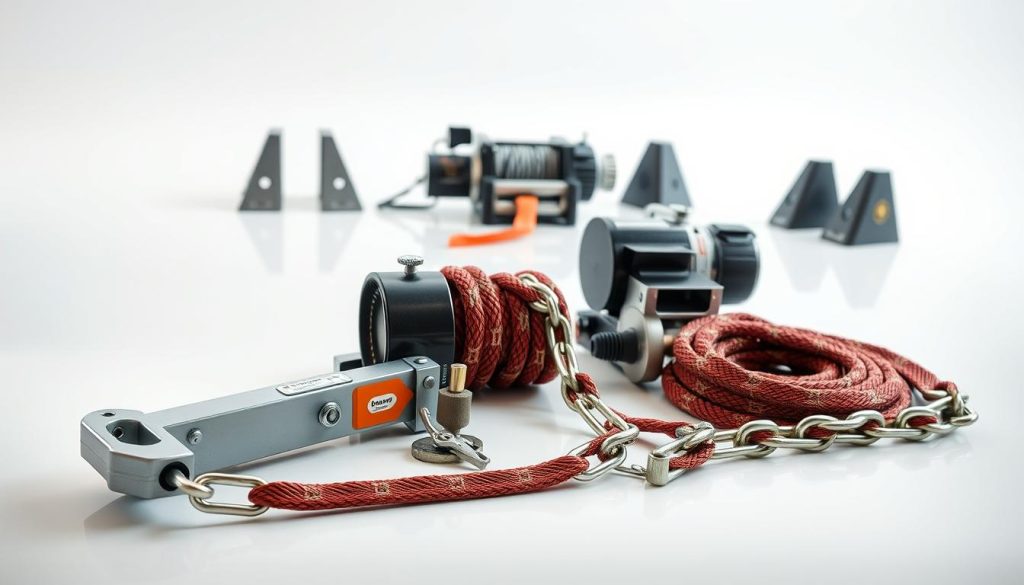
The Sequoia comes with a Class IV hitch for up to 9,520 lbs. But, aftermarket hitches offer more choices. Here’s what you should know:
| Feature | OEM Hitch | Aftermarket |
|---|---|---|
| Warranty Coverage | Full vehicle warranty | Limited manufacturer |
| Installation Cost | Included at purchase | $200-$500+ |
| Weight Capacity | Matched to factory specs | Up to 14,000 lbs |
Pro Tip: Aftermarket hitches are great for specialized trailers. OEM hitches keep your vehicle looking right.
3.2 Weight Distribution Systems Explained
Load-leveling air suspension is a plus for Platinum trims. But, most people need more help:
- Equalizes trailer weight across axles
- Prevents headlight misalignment
- Reduces trailer sway by 40% (NHTSA data)
Look for systems with sway control. They should work with Toyota Safety Sense™.
3.3 Must-Have Electronic Accessories
For safe towing, you need smart tech. These two are essential for Sequoia towing:
3.3.1 Trailer Brake Controllers
The Sequoia is ready for in-cab controllers. They:
- Sync trailer brakes with vehicle ABS
- Allow manual braking adjustments
- Display real-time trailer status
3.3.2 Backup Camera Systems
Toyota’s Trailer Backup Guide uses cameras to:
- Display projected trailer path
- Alert to jackknife risks
- Maintain visibility in 360° view
“Integrated camera systems reduce backing accidents by 78% when towing”
Pre-Towing Vehicle Preparation Checklist
Before you hitch your trailer to the Toyota Sequoia, make sure you’re ready. This ensures you stay within its tow rating and protects your vehicle. Here are three key areas to focus on before you hit the road.
4.1 Engine Cooling System Inspection
The Sequoia’s i-FORCE MAX hybrid engine works great under load. But, it needs a perfect cooling system. Here’s a quick checklist:
- Check coolant levels between MIN/MAX marks (use Toyota Super Long Life Coolant)
- Inspect hoses for cracks or soft spots near clamps
- Clean radiator fins of debris with compressed air
- Test electric cooling fan operation at idle
Hybrid systems get hot during regenerative braking. It’s important to check everything before towing for a long time.
4.2 Suspension Upgrades for Heavy Loads
The Sequoia’s Adaptive Variable Suspension is good for moderate loads. But, for the best tow rating Toyota Sequoia, consider these upgrades:
- Air suspension helper kits: Keep ride height even with load changes
- Progressive-rate rear springs: Prevent sag without losing ride quality
- Upgraded sway bars: Less body roll during turns
These upgrades work well with the factory 10-speed transmission’s tow/haul mode.
4.3 Tire Pressure Monitoring Best Practices
Your Sequoia’s tires are key to avoiding load-related blowouts. Here’s a pressure strategy:
- Set cold PSI to manual’s recommended max (usually 35-42 PSI)
- Recheck pressures after 15 miles of driving
- Never reduce pressure when tires heat up – it’s normal to gain 4-6 PSI
Remember, underinflated tires overheat faster. Overinflation can reduce traction during stops.
Calculating Your Total Load Weight
How much can your Toyota Sequoia actually tow without straining its systems? The answer lies in precise calculations. These calculations factor in everything from passengers to trailer mechanics. Let’s break down three critical steps to ensure you stay within the towing capacity of Toyota Sequoia while maintaining safety margins.
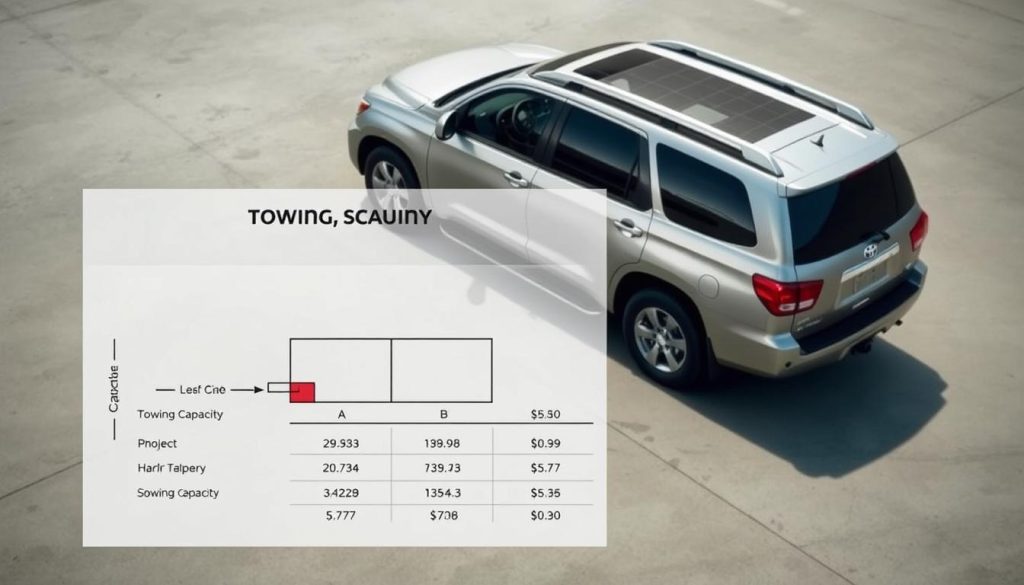
Using CAT Scales Effectively
Commercial truck scales (CAT scales) provide the most accurate way to measure your total load. Here’s how to use them:
- Weigh your Sequoia unhitched with all passengers and gear
- Measure the combined weight with trailer attached
- Subtract the first measurement from the second to get trailer weight
Most CAT scales now offer mobile apps for instant digital reports. These apps are perfect for verifying you’re below the Sequoia’s 1,730 lb payload limit.
Accounting for Passengers and Gear
Many owners forget that payload capacity includes everything inside the vehicle. A family camping trip adds up faster than you’d think:
| Item | Average Weight | Sequoia Capacity Impact |
|---|---|---|
| 4 passengers | 680 lbs | 39% of payload |
| Camping gear | 250 lbs | 14% of payload |
| Tongue weight | 520 lbs | 30% of payload |
This sample calculation leaves just 280 lbs for additional cargo. Emphasize weight tracking for safety.
Tongue Weight Calculation Formulas
The golden rule for towing capacity of Toyota Sequoia requires 10-15% of trailer weight on the hitch. Use this formula:
Tongue Weight = Total Trailer Weight × 0.10 to 0.15
For a 7,000 lb trailer, aim for 700-1,050 lbs on the hitch. Always verify with a dedicated tongue weight scale. Guessing can lead to dangerous sway at highway speeds.
Choosing the Right Hitch Class
Choosing the right hitch class is key to safely using your Toyota Sequoia’s 9,520-pound tow capacity. The right hitch prevents damage to your vehicle and keeps control of heavy loads. Here are three important things to consider when picking a hitch.
Class IV vs Class V Hitches Compared
Most Sequoia owners will find Class IV hitches perfect for daily towing. These hitches can handle up to 10,000 pounds, great for boats, campers, or horse trailers. They also work with most aftermarket accessories like bike racks or cargo carriers.
Class V hitches can handle up to 17,000 pounds but are heavier. While the Sequoia’s i-FORCE MAX hybrid system might handle this, it’s not needed for most users. Save Class V hitches for commercial trucks or heavy-duty jobs.
| Feature | Class IV | Class V |
|---|---|---|
| Max Weight | 10,000 lbs | 17,000 lbs |
| Receiver Size | 2″ | 2.5″ |
| Best For | Recreational towing | Commercial use |
When You Need Weight Distribution
Weight distribution hitches are a must for loads over 5,000 pounds. These systems:
- Balance trailer weight across all axles
- Improve braking performance
- Reduce trailer sway by 40-60%
For the Sequoia’s maximum tow capacity, pair your hitch with a quality weight distribution system. Toyota recommends specific models that work with the vehicle’s stability control features.
Gooseneck vs Fifth-Wheel Options
Platinum trim models are ready for gooseneck hitches. These are great for hauling livestock trailers or construction equipment. Gooseneck hitches:
- Offer better weight distribution
- Allow tighter turning radius
- Require bed-mounted installation
Fifth-wheel hitches are best for large RVs but need permanent mounting. Given the Sequoia isn’t a full-size pickup, gooseneck setups are better for heavy-duty needs. Always check that the hitch rating matches your trailer’s weight.
Safe Towing Techniques With Your Sequoia
Learning to tow your Toyota Sequoia well is about using its power wisely. It’s about knowing how to drive safely when you’re hauling stuff. Here are three key safety tips every driver should know.
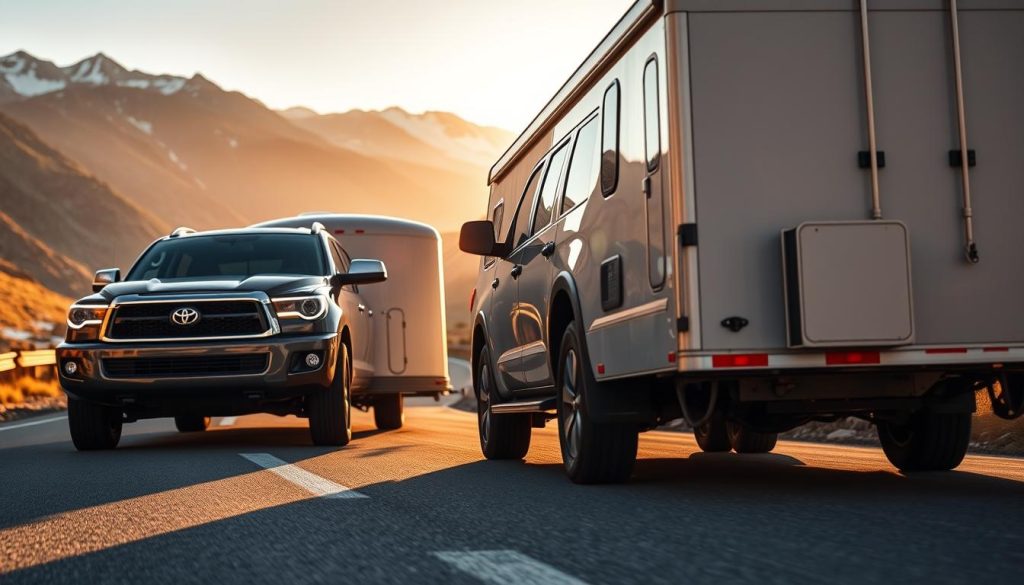
7.1 Managing Trailer Sway Emergencies
The Sequoia has a Trailer-Sway Control system. It helps by adjusting the engine and brakes if the trailer starts to sway. If sway happens:
- Grip the wheel firmly without overcorrecting
- Gradually reduce speed using the brake controller
- Activate Straight Path Assist via the center console
| Sway Control Method | Response Time | Driver Action Required |
|---|---|---|
| Automatic Braking | 0.5 seconds | None |
| Manual Speed Reduction | 2-3 seconds | Foot off accelerator |
| Straight Path Assist | Instant | Button press |
7.2 Hill Descent Control Operation
Going down steep hills with a heavy load? The Sequoia’s Hill Descent Control keeps you moving at 3-5 mph. Try it out on gravel roads before you hit the mountains:
- Shift into 4WD Low mode
- Press the HDC button near the gear selector
- Use steering wheel controls to set desired speed
7.3 Proper Mirror Adjustment Methods
For better visibility, adjust your mirrors like this:
- Extend towing mirrors until trailer edges are visible
- Angle convex mirrors downward to view hitch area
- Enable the digital rearview mirror for wide-angle coverage
The 360-degree camera system is also great. It helps when you’re backing up or changing lanes.
Routine Maintenance for Heavy Towing
Keeping your Toyota Sequoia in top shape for heavy hauling is key. It’s not just about occasional checkups. Regular maintenance keeps your haul capacity Toyota Sequoia reliable. Here are three important areas to focus on for frequent towing.
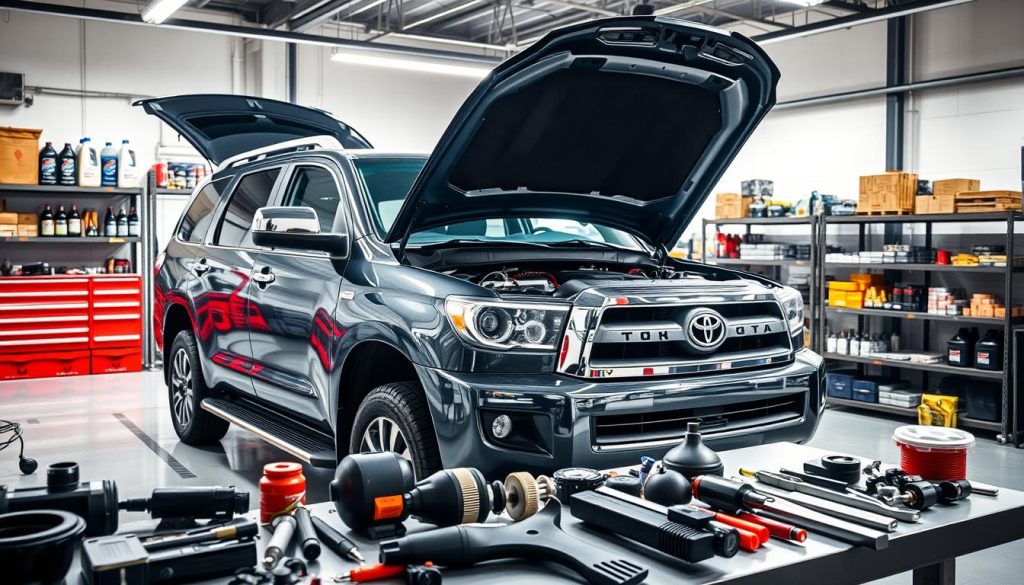
Transmission Fluid Change Intervals
The Sequoia’s 10-speed transmission works harder when towing. Toyota suggests changing fluid every 60,000 miles normally. But, heavy towing cuts this interval in half.
Change fluid every 30,000 miles if you tow trailers up to 9,500 pounds often. Hybrid models need extra care. Their i-FORCE MAX system generates more heat, breaking down fluid faster.
Brake System Inspection Schedule
Brakes wear 40% faster when stopping heavy loads. Check these components every 5,000 miles or before long trips:
- Pad thickness (replace below 3mm)
- Rotor warping signs
- Fluid contamination
Upgrade to heavy-duty brake pads for mountainous areas. Always use Toyota-approved fluid to keep warranty coverage.
Cooling System Maintenance Tips
The hybrid powertrain’s radiator needs special attention. Follow this checklist every 15,000 miles:
| Component | Check For | Action Required |
|---|---|---|
| Radiator Fins | Bent/Damaged sections | Straighten with fin comb |
| Coolant Hoses | Soft spots or cracks | Replace immediately |
| Coolant Mix | Proper 50/50 ratio | Flush system every 30k miles |
Clean debris from the grille monthly. Even small leaves can reduce airflow to critical components.
Understanding State Towing Regulations
Your Toyota Sequoia can tow up to 9,520 lbs. But, state laws add more rules for safe towing. Knowing these laws helps you avoid fines and keeps you safe on the road. Here are the key regulations you need to know.

Maximum Length Requirements by State
Trailer length limits change a lot in the U.S. For example:
| State | Max Trailer Length | Combined Vehicle Length |
|---|---|---|
| Texas | 59 ft | 65 ft |
| California | 48 ft | 65 ft |
| Florida | 53 ft | 60 ft |
| New York | 48 ft | 60 ft |
Always check your rig’s length from bumper to trailer tail before driving.
Trailer Brake Laws Overview
Most states need electric brakes for trailers over 3,000 lbs. But:
- Colorado: Mandatory brakes at 2,000 lbs
- Alaska: No brake requirements for non-commercial trailers
- Arizona: Breakaway systems required over 6,000 lbs
“Brake laws exist to prevent jackknifing – never assume one state’s rules apply elsewhere.”
CDL Requirements for Heavy Loads
Your Sequoia can tow up to 9,520 lbs, which is below the 26,000-lb CDL limit. But, some states have their own rules:
In Michigan, you need a non-commercial Class A license for trailers over 10,000 lbs. Pennsylvania doesn’t require it for recreational vehicles. Always check local licensing needs before towing near your SUV’s max capacity.
Performance Upgrades for Increased Capacity
Boosting your Toyota Sequoia’s towing power is more than just about raw strength. It’s about upgrading key parts for safer, more efficient hauling. While the standard setup works well for most tasks, serious haulers often look for targeted improvements to safely push their SUV’s limits. Let’s dive into three essential upgrades that enhance performance without sacrificing reliability.
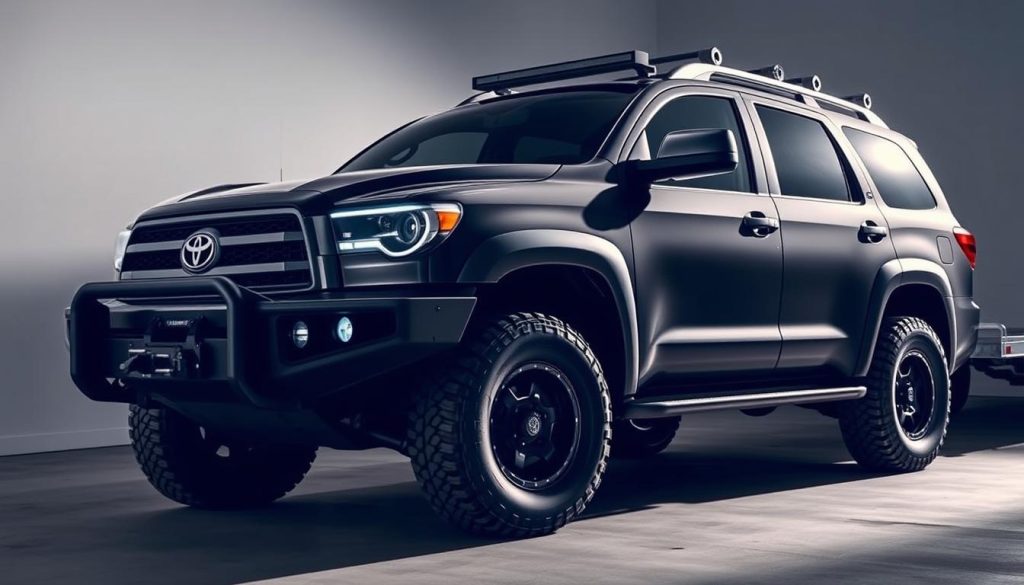
Aftermarket Suspension Packages
The TRD Pro suspension is already tough, but heavy haulers might want air suspension systems like Capstone’s LoadMaster series. These kits:
- Adjust ride height based on load weight
- Lessen sagging under heavy loads
- Boost stability at high speeds
Important note: Some dealerships might void warranties on suspension parts if aftermarket upgrades cause failures. Always check with your service advisor before making changes.
Engine Tuning Considerations
Modern SUVs, like the Sequoia, can greatly benefit from professional ECU recalibrations that fine-tune the i-FORCE MAX hybrid system. Trusted tuners can:
- Boost low-end torque by 10-15%
- Enhance throttle response
- Keep emissions in check
“Aggressive tuning can stress drivetrain parts. Always go with certified Toyota experts for tweaks.”
Transmission Cooler Installations
Even with factory coolers, adding an auxiliary transmission cooler offers extra protection on long trips. The benefits include:
- 20-30°F lower operating temperatures
- Longer intervals between fluid changes
- Less wear on clutch packs
Installation usually takes 2-3 hours at certified shops. Using synthetic transmission fluid will give you the best results.
Real-World Towing Scenarios
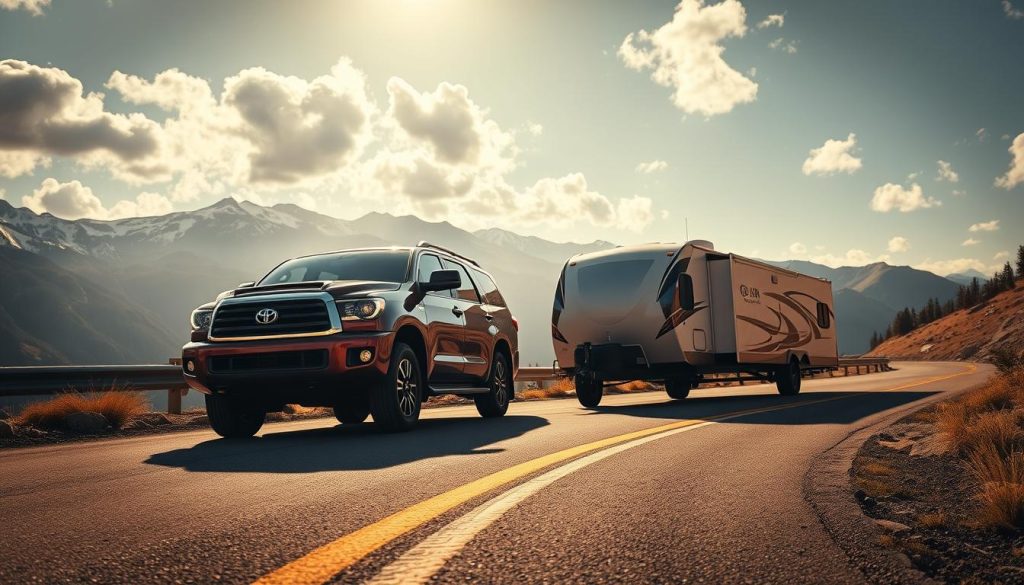
Using your Toyota Sequoia’s 9,520 lb tow rating means knowing how it works in real life. We’ll look at three common situations where planning is key for safe towing.
Towing a 28-Foot Travel Trailer
A loaded 28-foot travel trailer weighs about 7,500 lbs. Here’s how to use your Sequoia’s capacity:
- Calculate payload: Subtract trailer weight from 9,520 lb capacity
- Account for passengers and gear (add 1,200-1,500 lbs)
- Use weight distribution hitch for stability
| Scenario | Trailer Weight | Payload Used | Safety Margin |
|---|---|---|---|
| Family Camper | 7,500 lbs | 8,720 lbs | 800 lbs |
| Equipment Haul | 9,000 lbs | 9,300 lbs | 220 lbs |
| Boat Transport | 6,200 lbs | 7,100 lbs | 2,420 lbs |
Hauling Construction Equipment
When moving skid steers or mini-excavators:
- Verify equipment weight with manufacturer specs
- Use trailer brakes for loads over 3,000 lbs
- Secure loads with grade-70 chains
Boat Launching Best Practices
Mastering ramp launches protects your Sequoia and watercraft:
- Engage 4Lo mode for controlled descent
- Check ramp condition before backing down
- Keep rear tires at water’s edge for retrieval
These examples show how the tow rating Toyota Sequoia owners rely on works in real life. Always double-check weights and use proper equipment to stay safe.
Common Towing Mistakes to Avoid
Towing with your Toyota Sequoia should feel empowering, not stressful. But even seasoned drivers make errors that strain their SUV or create safety risks. Let’s break down three frequent oversights and how to steer clear of them.
1. The Domino Effect of Poor Load Distribution
Loading your trailer like a game of Tetris? That’s a recipe for sway and instability. The 60/40 weight distribution rule is non-negotiable: 60% of cargo weight forward of the trailer’s axles, 40% behind. Common slip-ups include:
- Overloading the rear, causing fishtailing
- Ignoring trailer tire PSI (check manufacturer specs)
- Forgetting to test sway control systems
Remember: Your Sequoia’s 9,520-lb max towing capacity means nothing if weight isn’t balanced.
2. Skipping Trailer TLC
Trailers need love too. A 2023 study found 42% of tow-related breakdowns stem from neglected maintenance. Stick to this checklist:
- Inspect brakes every 3,000 miles or before long hauls
- Grease wheel bearings seasonally
- Verify tire pressure matches load requirements
Pro tip: Mark maintenance dates on your calendar. Your future self will thank you during that mountain pass descent.
3. Weather Blind Spots
That 25-mph crosswind? It feels like 40 mph when towing. Sudden storms reduce stopping distances by 30-50%. Always:
- Check route-specific weather apps
- Reduce speed before wind gusts hit
- Practice emergency stops in safe zones
Your Sequoia’s hybrid powertrain handles hills smoothly, but physics always wins. Plan ahead, and you’ll tow like a pro.
Recommended Towing Accessories
Enhance your Sequoia’s towing setup with these must-have add-ons. They boost safety and performance. Whether you’re towing a trailer or a boat, the right gear keeps you within the towing capacity of Toyota Sequoia. It also improves control. Let’s look at three key accessories for safe adventures.
1. Toyota Genuine Trailer Wiring Harness
Make trailer connections easy with Toyota’s OEM wiring harness. It’s made for the Sequoia and fits perfectly with your SUV’s electrical system. This plug-and-play accessory has color-coded connectors for easy setup. It also protects against voltage spikes and comes with a factory warranty.
2. Air Suspension Helper Kits
Heavy loads can make your rear suspension sag. This affects steering and tire wear. Air suspension kits, like those from Capstone Automotive, level your Sequoia with adjustable air springs. The 1794 Edition’s tech package works well with these systems, adjusting ride height based on payload. For heavy-duty towing, add TRD Pro-tuned shocks for better stability.
3. Wireless Camera Systems
Modern trailers need modern visibility. Wireless cameras, like the TRD Pro Multi-Terrain Monitor, attach to your trailer’s rear. They stream HD video to your dashboard. Key features include:
- Night vision for low-light boat launches
- Waterproof housing for rainy conditions
- 270-degree fish-eye lenses
Aftermarket systems work, but Toyota’s integrated option avoids signal interference. It syncs with the Sequoia’s touchscreen.
Conclusion
The Toyota Sequoia can tow up to 9,520 pounds when set up right. This makes it a great pick for SUV owners who need to haul a lot. To reach this top rating, you need to follow the guide’s tips.
TRD Pro models are special because they’re great for off-road adventures and towing. They have better suspension and are built tough. This means you can tow a boat or heavy equipment with confidence.
Using the right weight distribution and electronic tools makes the Sequoia a strong tow vehicle. Always stick to the load limits to keep your vehicle and others safe. Also, don’t forget to check your vehicle regularly, even more so when you’re towing a lot.
Want to see how the Sequoia handles towing? Visit your local Toyota dealer for a test drive. Bring your trailer details to see how the i-FORCE MAX hybrid system works with your setup.
FAQ
What’s the difference between payload and towing capacity for the Toyota Sequoia?
Payload capacity is how much your Sequoia can carry inside. This includes passengers, gear, and tongue weight. Towing capacity is how much it can pull. For example, if your Sequoia can carry 1,730 lbs, subtract the cargo and hitch weight to find the towing capacity.
How does the 2025 Sequoia TRD Pro compare to the Platinum trim for towing?
Both trims have the same i-FORCE MAX hybrid system (437 HP/583 lb-ft torque). But the Platinum has better cooling and a gooseneck hitch prep. The SR5 2WD model can tow up to 9,520 lbs. 4WD models can tow a bit less because they are heavier.
Should I use Toyota’s OEM hitch or an aftermarket option?
Toyota’s OEM hitch works with the Trailer Backup Guide system and keeps your warranty valid. Aftermarket Class V hitches can handle more weight but need a pro to install. All Sequoias are ready for trailer brakes, but you need an integrated brake controller for trailers over 3,000 lbs.
What maintenance does the Sequoia require for frequent towing?
Change the 7,500-mile transmission fluid and check the hybrid system’s radiator at each service. Keep rear tires at 35 PSI when towing near max capacity. Also, check the transmission cooler lines for leaks every year.
How do I calculate safe tongue weight for my trailer?
Use the 10-15% tongue weight rule. For a 7,500 lb trailer, 7,500 x 0.15 = 1,125 lbs. Subtract this from your payload capacity (1,730 lbs – 1,125 lbs = 605 lbs for passengers/gear). Always check weights at CAT scales before long trips.
Does the Sequoia require special equipment for gooseneck trailers?
Only the Platinum trim has gooseneck hitch preparation factory-installed. You need a fifth-wheel mounting system and air suspension helper kits (like Firestone Ride-Rite) for proper bed height. Toyota’s Straight Path Assist helps manage long trailers in tight spaces.
What safety features help when towing in mountains?
The Sequoia’s Trailer Sway Control adjusts power and braking if sway is detected. Use Hill Descent Control on steep grades and Downhill Assist Control to keep 2-4 mph on boat ramps. The 1794 Edition’s panoramic camera system improves visibility during lane changes.
Can I tow over 10,000 lbs without a CDL?
Most states let you tow up to 15,000 lbs without a CDL, but check local laws. The Sequoia’s max 9,520 lb rating is below most CDL thresholds. Always carry weight documentation and ensure trailer brakes work in all 50 states for loads over 3,000 lbs.
Does adding air suspension void my warranty?
Aftermarket systems like Air Lift 1000 don’t void warranties if installed right. But the Capstone’s adaptive air suspension needs dealer-approved servicing. Toyota Care coverage excludes damage from exceeding payload/towing limits in your owner’s manual.
What’s the best way to launch a boat with my Sequoia?
Engage 4LO mode for slippery ramps and use the 360-degree camera to align trailer guides. Keep rear tires at 35 PSI for better grip and disable Auto Start-Stop for consistent power. The TRD Pro’s crawl control helps recover from soft sand situations.
